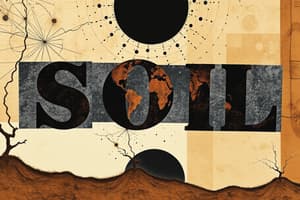Podcast
Questions and Answers
The study of soil as a natural resource is known as ______.
The study of soil as a natural resource is known as ______.
soil science
The layers of soil with distinct characteristics are referred to as ______.
The layers of soil with distinct characteristics are referred to as ______.
soil horizons
Organic matter in soil consists of decomposed plant and animal ______.
Organic matter in soil consists of decomposed plant and animal ______.
residues
The art and science of growing fruits and vegetables is known as ______.
The art and science of growing fruits and vegetables is known as ______.
Conservation tillage techniques aim to reduce ______ to preserve soil structure.
Conservation tillage techniques aim to reduce ______ to preserve soil structure.
Integrated pest management (IPM) strategies are part of ______ management.
Integrated pest management (IPM) strategies are part of ______ management.
Nutrient contents like N, P, K, and Ca are essential for ______ growth.
Nutrient contents like N, P, K, and Ca are essential for ______ growth.
Sustainable practices use soil science to inform ______ and agronomic practices.
Sustainable practices use soil science to inform ______ and agronomic practices.
Flashcards are hidden until you start studying
Study Notes
Soil Science
- Definition: The study of soil as a natural resource, including its formation, classification, mapping, and its physical, chemical, and biological properties.
- Components of Soil:
- Mineral Particles: Sand, silt, clay
- Organic Matter: Decomposed plant and animal residues
- Water and Air: Fill spaces between soil particles
- Soil Horizons: Layers of soil, each with distinct characteristics (O, A, E, B, C, R horizons).
- Soil Properties:
- Texture: Influences water retention and nutrient availability.
- Structure: Affects aeration and root growth.
- pH: Impacts nutrient solubility and microbial activity.
- Nutrient Content: Essential for plant growth (N, P, K, Ca, Mg, S, Micro-nutrients).
Horticulture
- Definition: The art and science of growing fruits, vegetables, nuts, seeds, herbs, sprouts, mushrooms, algae, and non-food crops (flowers, seaweeds, and non-food plants).
- Key Areas:
- Ornamental Gardening: Design and maintenance of landscape plants.
- Fruit and Vegetable Production: Cultivation practices for yield maximization.
- Landscape Horticulture: Planning and implementation of green spaces.
- Soil Management: Importance of healthy soil for plant growth; includes composting, mulching, and keeping soil covered.
- Pest Management: Integrated pest management (IPM) strategies aimed at minimizing chemical input.
Agronomy
- Definition: The science of soil management and crop production.
- Focus Areas:
- Crop Production: Techniques to enhance yield and quality.
- Soil Health: Sustainable practices to maintain and improve soil fertility.
- Crop Rotation and Diversification: Reduces pests and improves soil health.
- Key Practices:
- Irrigation Management: Efficient use of water resources for crops.
- Fertilization: Use of organic and inorganic fertilizers to supply nutrients.
- Conservation Tillage: Reducing soil disturbance to preserve soil structure and health.
Interrelationship Between Soil Science, Horticulture, and Agronomy
- Soil Health: Central to both horticulture and agronomy, influencing plant growth and crop yields.
- Sustainable Practices: Emphasis on using soil science to inform horticultural and agronomic practices for long-term sustainability.
- Research and Development: Continuous improvements in soil management techniques directly benefit both horticulturists and agronomists.
Soil Science
- The study of soil as a natural resource, encompassing its formation, classification, mapping, and its physical, chemical, and biological properties.
- Soil is comprised of mineral particles (sand, silt, clay), organic matter (decomposed plant and animal residues), and water and air filling the spaces between soil particles.
- Soil horizons are layers with distinct characteristics, denoted as O, A, E, B, C, and R horizons.
- Soil texture influences water retention and nutrient availability.
- Soil structure affects aeration and root growth.
- Soil pH impacts nutrient solubility and microbial activity.
- Nutrient content is essential for plant growth, including macro-nutrients (N, P, K, Ca, Mg, S) and micro-nutrients.
Horticulture
- The art and science of growing plants, including fruits, vegetables, nuts, seeds, herbs, sprouts, mushrooms, algae, and non-food crops like flowers, seaweeds, and non-food plants.
- Key areas within horticulture encompass ornamental gardening, fruit and vegetable production, landscape horticulture, and soil management.
- Soil management in horticulture emphasizes healthy soil for plant growth, including composting, mulching, and keeping soil covered.
- Pest management involves implementing integrated pest management (IPM) strategies to minimize chemical input.
Agronomy
- The science of soil management and crop production.
- Focuses on crop production techniques to enhance yield and quality, soil health through sustainable practices, and practices like crop rotation and diversification to reduce pests and improve soil health.
- Key agronomic practices include irrigation management for efficient water use, fertilization with organic and inorganic fertilizers, and conservation tillage to reduce soil disturbance and preserve soil structure and health.
Interrelationship of Soil Science, Horticulture, and Agronomy
- Soil health is crucial for both horticulture and agronomy, directly impacting plant growth and crop yields.
- Sustainable practices in both fields rely heavily on soil science to inform practices for long-term sustainability.
- Research and development in soil management techniques directly benefit horticulturists and agronomists, leading to improvements in these practices.
Studying That Suits You
Use AI to generate personalized quizzes and flashcards to suit your learning preferences.




